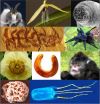(Press-News.org) For decades, neurologists have known that a diet high in fat and extremely low in carbohydrates can reduce epileptic seizures that resist drug therapy. But how the diet worked, and why, was a mystery—so much so that in 2010, The New York Times Magazine called it "Epilepsy's Big, Fat Miracle."
Now, researchers at Dana-Farber Cancer Institute and Harvard Medical School have proposed an answer, linking resistance to seizures to a protein that modifies cellular metabolism in the brain. The research, to be published in the May 24th issue of the journal Neuron, may lead to the development of new treatments for epilepsy.
The research was led jointly by Nika Danial, HMS assistant professor of cell biology at Dana-Farber Cancer Institute, and Gary Yellen, professor of neurobiology at Harvard Medical School. The first author was Alfredo Giménez-Cassina, a research fellow in Danial's lab.
Epilepsy is a neurological disorder characterized by repeated seizures, an electrical storm in the brain that can manifest as convulsions, loss of motor control, or loss of consciousness. Some cases of epilepsy can be improved by a diet that drastically reduces sugar intake, triggering neurons to switch from their customary fuel of glucose to fat byproducts called ketone bodies. The so-called ketogenic diet, which mimics effects of starvation, was described more than 80 years ago and received renewed interest in the 1990s. Recent studies corroborate that it works, but shed little light on how.
"The connection between metabolism and epilepsy has been such a puzzle," said Yellen, who was introduced to the ketogenic diet through his wife, Elizabeth Thiele, HMS professor of neurology, who directs the Pediatric Epilepsy Program at MassGeneral Hospital for Children, but was not directly involved in the study. "I've met a lot of kids whose lives are completely changed by this diet," Yellen said. "It's amazingly effective, and it works for many kids for whom drugs don't work."
"We knew we needed to come at this link between metabolism and epilepsy from a new angle," said Danial, who had previously discovered a surprising double duty for a protein known for its role in apoptosis: The protein, BCL-2-associated Agonist of Cell Death, or BAD, also regulated glucose metabolism.
Giménez-Cassina further discovered that certain modifications in BAD switched metabolism in brain cells from glucose to ketone bodies. "It was then that we realized we had come upon a metabolic switch to do what the ketogenic diet does to the brain without any actual dietary therapy," said Gimenez-Cassina, who went on to show that these same BAD modifications protect against seizures in experimental models of epilepsy. Still, it wasn't clear exactly how.
Yellen suspected the solution involved potassium ion channels. While sodium and calcium ion channels tend to excite cells, including neurons, potassium channels tend to suppress cell electrical activity. His lab had previously linked ketone bodies to the activation of ATP-sensitive potassium (KATP) channels in neurons. Yellen had hypothesized that the ketogenic diet worked because ketone bodies provide neurons enough fuel for normal function, but when the electrical and energy storm of an epileptic seizure threatens, the activated KATP channels can shut the storm down. But the effects of diets are broad and complex, so it was impossible to say for sure.
The effects that Danial's lab had discovered—BAD's ability to alter metabolism and seizures—offered a new avenue for studying the therapeutic effects of altered metabolism. Together, the researchers decided to investigate whether Danial's switch governed Yellen's pathway, and whether they could reverse engineer the seizure protection of a ketogenic diet.
They could. Working in genetically altered mice, the researchers modified the BAD protein to reduce glucose metabolism and increase ketone body metabolism in the brain. Seizures decreased, but the benefit was erased when they knocked out the KATP channel—strong evidence that a BAD-KATP pathway conferred resistance to epileptic seizures. Further experiments suggested that it was indeed BAD's role in metabolism, not cell death that mattered. The findings make the BAD protein a promising target for new epilepsy drugs.
"Diet sounds like this wholesome way to treat seizures, but it's very hard. I mean, diets in general are hard, and this diet is really hard," said Yellen, whose wife's Center for Dietary Therapy in Epilepsy hosts a candy-free Halloween party for its many patients on the ketogenic diet. "So finding a pharmacological substitute for this would make lots of people really happy."
INFORMATION:
The research was supported by Harvard Catalyst, Citizens United for Research in Epilepsy and the National Institutes of Health (research grants R56 NS072142, K01CA106596, R01 NS055031 and UL1 RR025758).
Written by R. Alan Leo
Citation:
Neuron, May 24, 2012
"BAD-Dependent Regulation of Fuel Metabolism and KATP Channel Activity Confers Resistance to Epileptic Seizures," Giménez-Cassina et al.
Harvard Medical School has more than 7,500 full-time faculty working in 11 academic departments located at the School's Boston campus or in one of 47 hospital-based clinical departments at 17 Harvard-affiliated teaching hospitals and research institutes. Those affiliates include Beth Israel Deaconess Medical Center, Brigham and Women's Hospital, Cambridge Health Alliance, Children's Hospital Boston, Dana-Farber Cancer Institute, Forsyth Institute, Harvard Pilgrim Health Care, Hebrew SeniorLife, Joslin Diabetes Center, Judge Baker Children's Center, Massachusetts Eye and Ear Infirmary, Massachusetts General Hospital, McLean Hospital, Mount Auburn Hospital, Schepens Eye Research Institute, Spaulding Rehabilitation Hospital, and VA Boston Healthcare System.
END
Children are more likely to have more body fat during childhood if their mother has low levels of Vitamin D during pregnancy, according to scientists at the Medical Research Council Lifecourse Epidemiology Unit (MRC LEU), University of Southampton.
Low vitamin D status has been linked to obesity in adults and children, but little is known about how variation in a mother's status affects the body composition of her child.
Low vitamin D status is common among young women in the UK, and although women are recommended to take an additional 10μg/day of vitamin D in ...
Dr. Daniel Micheals, Frederick podiatrist from the Reconstructive Foot & Ankle Institute, is happy to be able to offer weekly newsletters to his patients. The newsletters are designed to increase patients' awareness of different foot-related topics.
With topics ranging from stress fractures to athlete's foot, the Frederick, MD podiatrist's newsletters are designed to cover a large range of topics. It is very important to take care of your feet and ankles and Dr. Michaels hopes that the newsletters help to educate his patients to give them the knowledge necessary ...
The influence of the ground beneath us on the air around us could be greater than scientists had previously thought, according to new research that links the long-ago proliferation of oxygen in Earth's atmosphere to a sudden change in the inner workings of our planet.
Princeton University researchers report in the journal Nature that rocks preserved in the Earth's crust reveal that a steep decline in the intensity of melting within the planet's mantle — the hot, heat-transferring rock layer between the crust and molten outer core — brought about ideal conditions for the ...
Jeanne T. from Minnesota had spent too many hours at big box stores looking for something beyond the common and generic vanities they offered to complete her dream home renovation. Eventually, she knew she had to shop online. Still though, after perusing a few online stores and finding all of the same boring options, she was ready to give up. It was just then that she stumbled upon Unique Online Furniture's site at Unique Vanities. She later admitted to a Product Specialist, "I was so excited to find you guys! I felt like I had looked at 800 vanities... and they were ...
Scientists at the University of British Columbia and the Smithsonian Institution have discovered a sensory organ in rorqual whales that coordinates its signature lunge-feeding behaviour – and may help explain their enormous size.
Rorquals are a subgroup of baleen whales – including blue, fin, minke and humpback whales. They are characterized by a special, accordion-like blubber layer that goes from the snout to the navel. The blubber expands up to several times its resting length to allow the whales to engulf large quantities of prey-laden water, which is then expelled ...
TEMPE, Ariz. – The International Institute for Species Exploration at Arizona State University and a committee of scientists from around the world announced their picks for the top 10 new species described in 2011. This is the fifth year for the top 10 new species list, which was released May 23 to coincide with the anniversary of the birth of Carolus Linnaeus, the Swedish botanist who was responsible for the modern system of plant and animal names and classifications.
On this year's top 10 new species list are a sneezing monkey, a beautiful but venomous jellyfish, an ...
Researchers have shown in mice how immune cells in the brain target and remove unused connections between brain cells during normal development. This research, supported by the National Institutes of Health, sheds light on how brain activity influences brain development, and highlights the newly found importance of the immune system in how the brain is wired, as well as how the brain forms new connections throughout life in response to change.
Disease-fighting cells in the brain, known as microglia, can prune the billions of tiny connections (or synapses) between neurons, ...
A novel anti-inflammatory drug could help to improve survival in the most severe cases of malaria by preventing the immune system from causing irrevocable brain and tissue damage.
Walter and Eliza Hall Institute researchers have shown that a new class of anti-inflammatory agents, called IDR (innate defense regulator) peptides, could help to increase survival from severe clinical malaria when used in combination with antimalarial drugs.
A research team fronted by Dr Ariel Achtman and Dr Sandra Pilat-Carotta, and led by Professor Louis Schofield from the institute's Infection ...
Ultracold quantum gases are an ideal experimental model system to simulate physical phenomena in condensed matter. In these gases, many-body states can be realized under highly controlled conditions and interactions between particles are highly tuneable. A research group led by Wittgenstein awardee Rudolf Grimm and START awardee Florian Schreck have now realized and comprehensively analyzed repulsive polarons for the first time. The scientists from the Institute of Quantum Optics and Quantum Information (IQOQI) of the Austrian Academy of Sciences and the Institute for Experimental ...
Announce It! has added three new themes to its unique line of personalized party favors. These themes are available for ordering now.
The new themes are baby shower birds nest, wedding peacock, and personal monogram style wedding designs. Announce It! owner Lori Shirley believes that customers will find these new themes a perfect way to express the joy of their occasion. "I keep a watchful eye on all special occasions along with an open ear as to how people want to express those occasions," she says.
Along with these new themes, customers can look forward ...



